7 Reasons for Dog Panting In Car [Warning!]
Dogs can make excellent traveling companions! What’s a road trip without your canine best buddy?
Whether we’re running errands in town or going across the nation, you’ll want to have your beloved pooch all safe and comfy in your car. A well-behaved, relaxed pooch that has great car manners will make it an enjoyable trip for everyone.
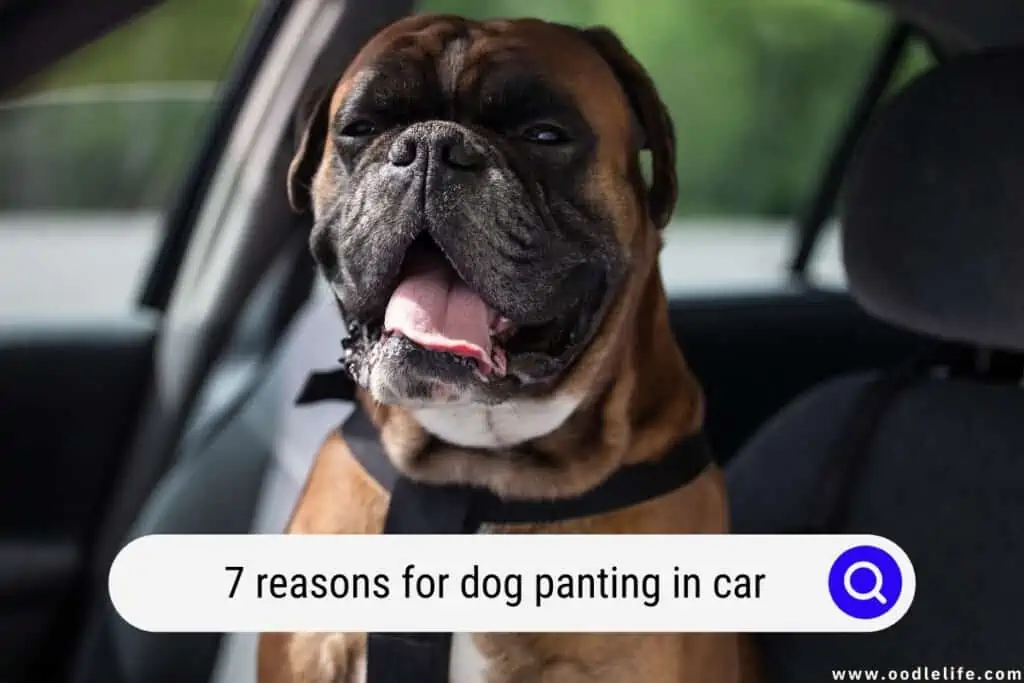
Why Do Dogs Pant?
Dogs pant for a variety of reasons – to cool off, to relieve anxiety, and even when they’re excited. But why does this strange behavior work? Turns out, it’s all about the dog’s anatomy.
Panting is completely natural for dogs. Dogs don’t sweat as humans do, so they have to rely on other means to regulate their body temperature. Panting helps dogs to evaporate the moisture in their lungs, which in turn helps to cool them down.
It’s vital to remember that some panting is perfectly normal. However, if the panting is accompanied by wheezing, whimpering, or other distressing noises, you should contact your dog’s veterinarian right once.
Excessive panting may indicate that your dog is having difficulties breathing or is experiencing an allergic response.
However, in most cases, panting is perfectly normal – and just another example of how dogs are uniquely adapted to their environment.
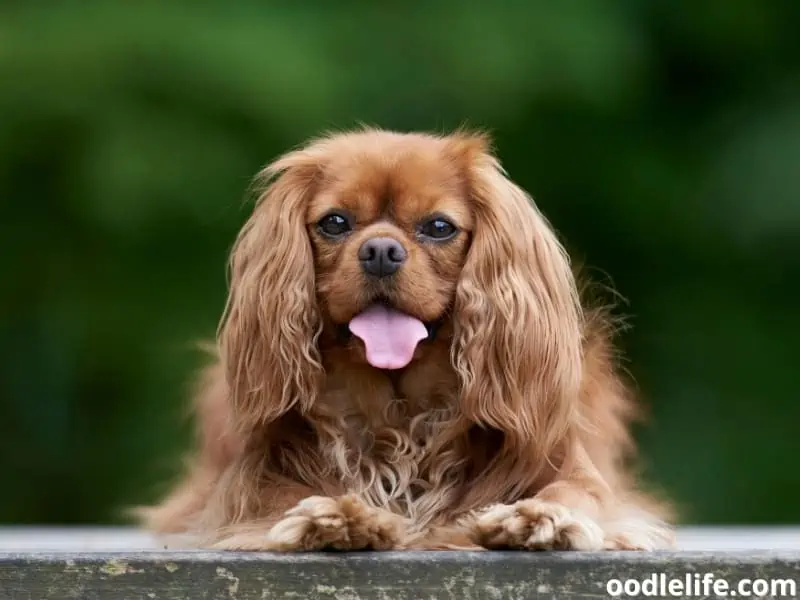
Excessive Panting In The Car
While panting is normal and even a slight increase in the vehemence of the panting can be due to excitement, excessive panting and drooling might indicate the onset of a more severe problem.
Some reasons that could quickly escalate into something you don’t want happening include:
1. Dehydration
A common side effect of overheating, dehydration is one of the causes of panting. Even if it is raining outside, dogs may become dehydrated!
Dogs that do not drink enough water are more likely to get dehydrated. Maybe you loaded up your dog in the car too soon after a big run or play session at the dog park before your dog has had time to consume enough water. Or maybe the summer’s heat is simply too hot for your double-coated, long-haired dog.
Dehydration results in a plethora of potentially dangerous symptoms. Your pooch may grow weak, lethargic, or lose consciousness. If your dog is thirsty, you may notice his tongue flying in the air, and excessive drooling.
Take this as a warning and act as soon as possible!
Solution
- If you feel that your dog’s panting is caused by dehydration, you must act quickly. Give them access to as much drinking water as you can.
- If your dog refuses to drink, allow him to cool down first in the shade before trying to water him again. If your dog steadfastly refuses to drink and shows other signs of lethargy and weakness, it might be time for the vet.
- Your veterinarian will assist you in diagnosing the problem so that you can remedy it. If necessary, your veterinarian can rehydrate your dog intravenously.
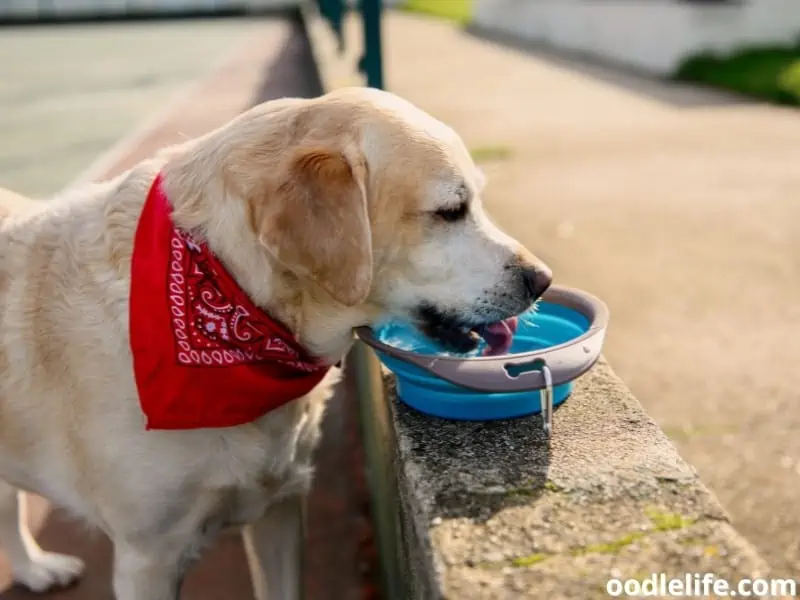
2. Overheating
Dogs have more difficulty expelling excess heat than us hoo-mans. They can’t sweat profusely through their skin to regulate their temperatures, but instead, have to sweat through panting, and their paws.
However, their thick fur coat often prevents them from using sweat mechanics to cool down. They just do not have the same number of sweat glands as we have!
If you suspect that your dog is overheating, there are a few signs to look for. First, check their body temperature. If it’s above 103 degrees Fahrenheit, they’re too hot.
Other signs include excessive panting and drooling, bright red tongue or gums, and glazed eyes. If your dog is showing any of these signs, it’s important to take action immediately.
Solution
- Move them to a cool area and give them some water to drink. You can also wet their ears, paws, and head with (not cold) water or apply a cool compress to their head and neck.
- Allow some time for the temperature to drop before re-entering the vehicle. This is especially important during the warmer summer months. The panting should stop after your dog has cooled down.
- If your dog’s condition doesn’t improve, seek professional medical attention.
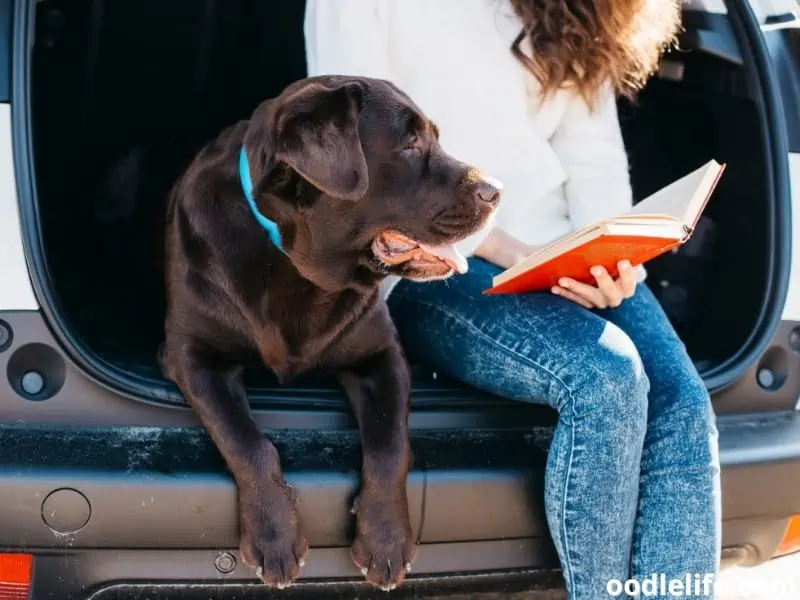
3. Motion Sickness
Dogs can have motion sickness too and puppies are notorious for this! Young puppies haven’t quite developed a knack for riding in a car, and also have a lesser sense of balance than adult dogs, often tumbling around the car and losing their footing.
Many puppies outgrow this predisposition, but some adult dogs carry it around their whole lives. If you have ever had motion or seasickness, you’ll know how unpleasant the nausea and vomiting can be.
When dogs start to get motion sickness, they may increase their panting because of their rising stress levels. However, just before they throw up, they have a tendency to stop panting, if only for a while. That’s a surefire sign that they are about to chuck!
Solution
There are several methods for dealing with motion sickness.
- The most straightforward solution is to limit your dog’s vision of the outside world. Most motion sickness is caused by a breakdown in communication between what your dog sees and what they feel in their inner ear.
- The same is true for people. We can, however, take action to mitigate the impacts. Dogs are unable to!
- Consider using a plastic kennel for your dog. Create a dark secure zone by covering the sides with a blanket. The effects of the automobile moving from side to side will still be felt by your dog.
- Some dog owners have reported that leaving the windows a little down to let some fresh air in has helped in preventing doggy motion sickness.
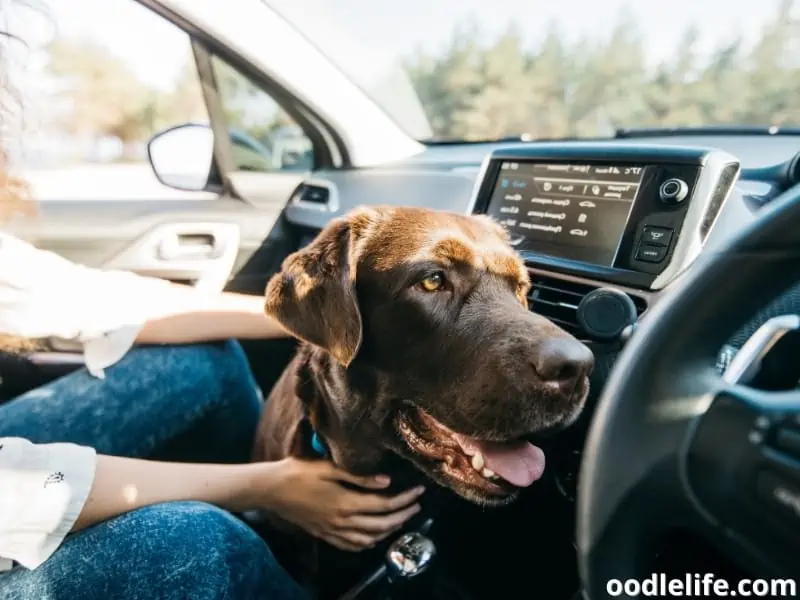
4. Anxiety
Many dog owners incorrectly perceive panting as their dog’s way of cooling down. However, one of the most common reasons for excessive panting is anxiety, which is difficult to spot unless you have seen it before.
Backseats can be uncomfortable, or your dog could dislike car rides (although this is rare – most dog LOVE road trips!).
Most owners will transport their dogs in the car’s backseat, which is separated from the driver’s seat. Your dog might be stressed because it is in a new situation and unable to get to you, which is why many dogs exhibit the dangerous behavior of clamoring all over the car trying to get to the passenger seat.
This is especially true for puppies. They want to be near you and be in the thick of the action, so when they are confined to a traveling crate or backseat, they might get stressed which might manifest in increased panting.
Solution
- Using a crate is the best solution! A properly sized kennel offers enough space for your dog to relax, as well as keeps your pooch from distracting you as you drive. Restricting their movement not only keeps them safer but also makes them more likely to sit, which will calm them down.
- Have someone ride with you and your dog until your dog settles down and gets used to car rides.
- If nothing else works, you might want to feed a natural supplement to calm your dog down.
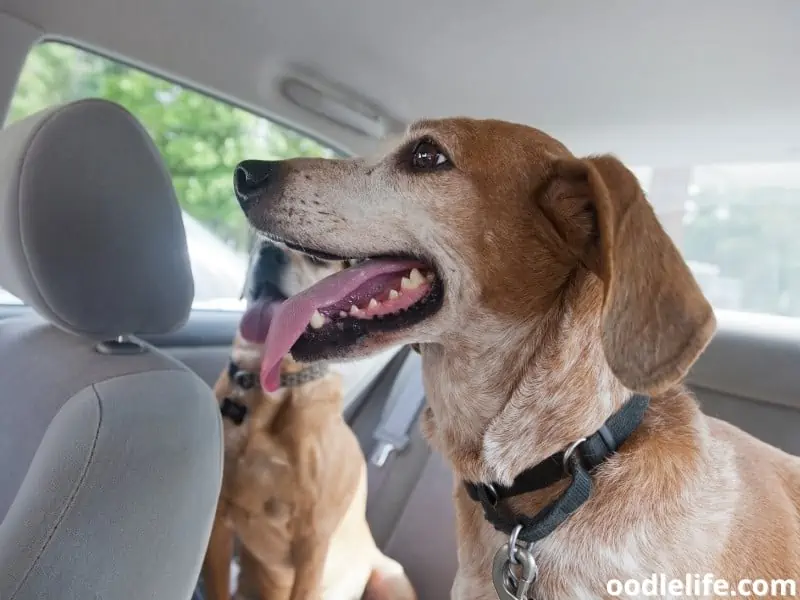
5. Excitement
This is the best reason of all. Most dogs LOVE road trips and will happily pant away the whole ride with their tongue hanging out from their mouths.
When a dog pants with excitement, their body is releasing small amounts of adrenaline. This helps to increase their heart rate and prepare their muscles for action.
Panting is frequently just a sign that your dog is happy and excited.
Solution
- Let your dog pant!
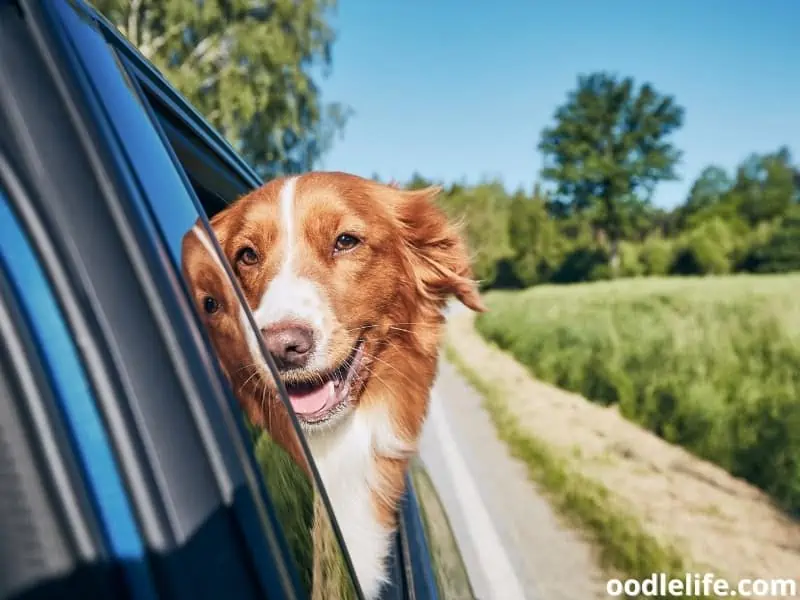
6. Physical Pain
Panting might sometimes indicate that your canine buddy is in discomfort or pain. Dogs in pain might exhibit behaviors like excessive panting which might be your dog’s way of dealing with the pain.
Solution
- If you suspect your dog seems to be in pain, don’t dismiss the panting. Consider it a warning indication that you should check into it more. Consult with your veterinarian!
- Only your veterinarian can make an accurate diagnosis for your dog and help rule out any underlying conditions or injuries.
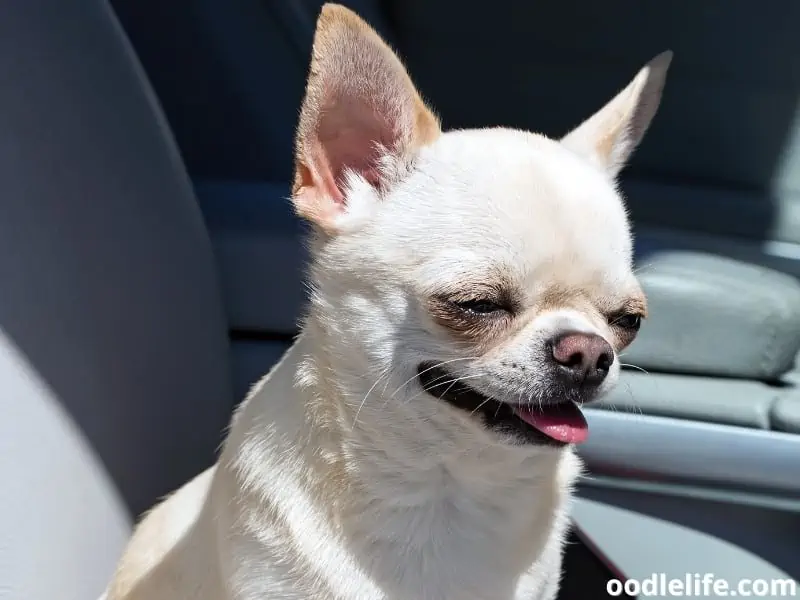
7. Overstimulation and Underexposure
Closely related to anxiety, an overstimulated dog may exhibit signs of restlessness, hyperactivity, and anxiety. If your dog is displaying these behaviors, it’s important to take steps to help them calm down.
One way to do this is to provide them with plenty of exercise before going for that car ride. A good game of fetch or a long walk will help to burn off excess energy before the trip to the store and allow your dog to relax in the car.
Solution
If your dog is showing signs of overstimulation in a car, go for frequent, short rides on gently curving roads to desensitize him to the situation, working yourself to longer rides with trickier roads.
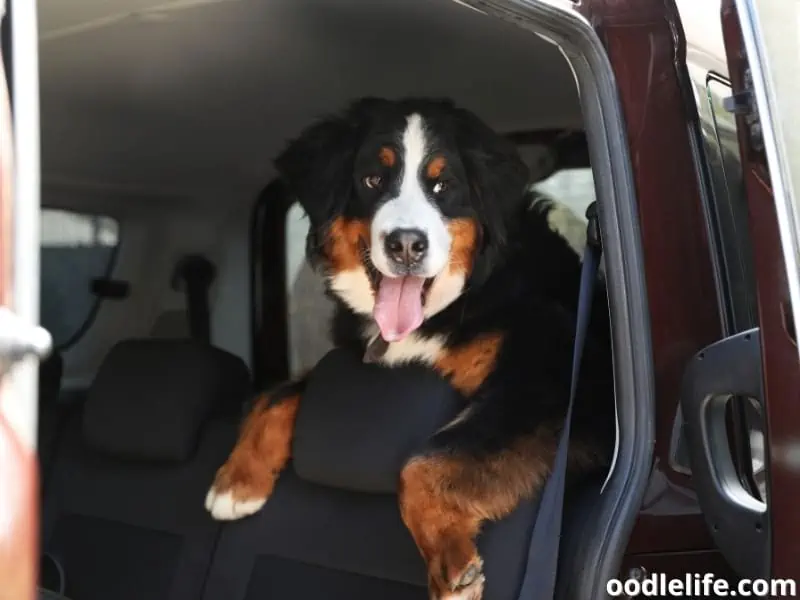
Final Thoughts
| Reason | Description | Example of Concern | Commonality Rating |
|---|---|---|---|
| Overheating | Dogs pant to cool down when they’re feeling too hot. Cars can get warm, especially if the air conditioning isn’t on or if the dog is in direct sunlight. | If your dog is panting heavily and appears distressed, it’s important to address the situation immediately by turning on the air conditioning or moving them to a cooler spot. | 9/10 |
| Anxiety and Stress | Dogs can experience anxiety and stress during car rides, particularly if they’re not used to them or if they associate the experience with something unpleasant (e.g., trips to the vet). | If your dog seems agitated or excessively panting due to anxiety, it’s important to address the issue and help them feel more comfortable. Some ways to do this include using a calming aid, creating a positive association with car rides, or seeking professional help from a trainer. | 7/10 |
| Excitement | Some dogs may pant from excitement when going for car rides, especially if they associate it with a fun destination (e.g., a park or doggy playdate). | If your dog’s panting is caused by excitement, it’s typically not a concern. However, it’s important to monitor their behavior and ensure they don’t become overly agitated or stressed. | 6/10 |
| Car Sickness | Dogs can experience motion sickness, which may cause panting, drooling, and general discomfort. | If your dog is panting due to car sickness, it’s essential to address the issue. You can try using natural remedies, altering the position of their crate or seat, or consulting with a veterinarian for medication. | 4/10 |
| Breathing Difficulties | Dogs with certain health issues or breeds with short noses (e.g., Pugs, Bulldogs) may pant more in the car due to difficulty breathing. | If your dog has an existing respiratory condition or is part of a brachycephalic breed, it’s important to monitor their panting and ensure they remain comfortable. Consult with a veterinarian for specific recommendations. | 3/10 |
| Dehydration | Dogs can become dehydrated quickly, especially during warm weather or after exercise. Panting may be an indicator that they need to rehydrate. | If your dog is panting due to dehydration, it’s essential to provide them with water and address the situation immediately. Make sure they have access to fresh water during car rides and monitor their hydration levels. | 5/10 |
Panting in a car is a regular occurrence in dogs but that is not to imply you should ignore it. Understanding your dog’s panting and reading between the lines might provide you with the knowledge you need to calm them down. With a little patience and effort, you can help your dog find their inner peace!
Don’t forget a doggy seatbelt to keep your buddy safe! A sudden brake can send your dog flying into your seat or onto your dash.
Have fun and happy tails!